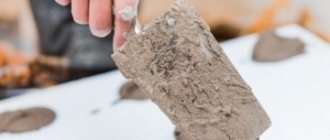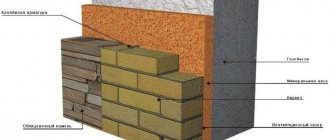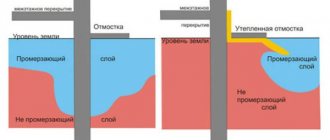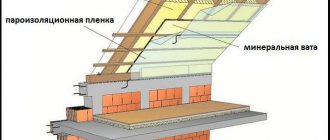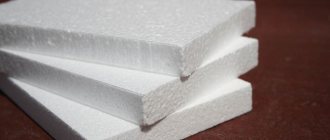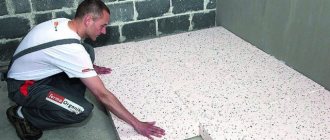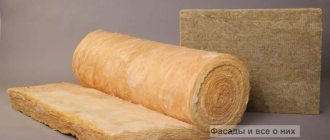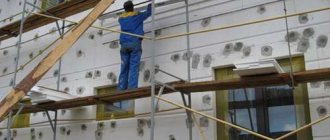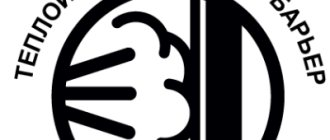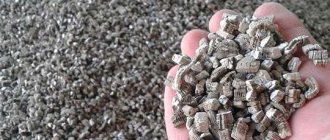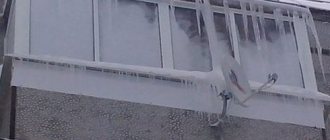Main characteristics of materials for thermal insulation
A very important task when insulating a brick house is choosing a reliable and durable material for treating the outer part of the walls.
It must have certain characteristics that must withstand precipitation, high humidity, wind and frost, as well as heat. Therefore, it is important to consider the following characteristics when choosing:
Water absorption. It is better to give preference to materials with a low water absorption coefficient. Thermal conductivity. This is the main criterion when choosing insulation. The amount of heated air in the house that is lost in one hour per square meter of material with a thickness of one meter depends on it. It is this indicator that you should rely on when choosing the thickness of the insulation layer. The most suitable materials for this would be polystyrene foam and mineral wool. Flammability. This characteristic determines the danger of the material in case of fire. Thus, products can be divided into 4 classes according to this characteristic, and it is better to give preference to G1, which can go out without an open flame
For example, polystyrene foam boards have a high ignition rate, and if they are used for cladding a house, you should choose the C marking, which means self-extinguishing. Pay attention to the density, which determines the amount of additional weight on the structure. The lower the indicator, the lighter the material will be. Sound insulation level
Allows you to reduce noise penetrating into the building. Almost all materials for thermal insulation have this characteristic. Environmental friendliness. For exterior wall decoration, this criterion is not particularly important, since it determines the level of health safety of the material. However, it is still better to use natural rather than synthetic materials. Difficult to install. In the case of finishing it yourself, without the help of specialists, it is better to give preference to a simple and understandable technology for laying heat-insulating material.
Thus, the choice of material is a decisive factor, depending on which the final result will depend, as well as the service life.
Insulation from the inside, how to avoid condensation
When it is not possible to install thermal insulation from the outside, it is installed from the inside. The main task is to avoid the appearance of condensation and moisture that is harmful to materials. Why do water drops appear on the wall?
This occurs when cold material comes into contact with warm steam from the room. In order for the wall to remain dry, it must be insulated from steam penetration. To do this you need:
use insulation with minimal vapor permeability, it is desirable that its value be lower than that of the wall; perform high-quality finishing from moisture-resistant plasterboard; use waterproofing fabric when installing insulation; reduce the humidity in the room using ventilation.
When choosing a material for thermal insulation, it is worth focusing on vapor-tight products: polystyrene foam, extruded polystyrene foam, polyurethane foam. It is possible to use mineral wool, but its installation will require a lot of effort:
it is necessary to fix the waterproofing to the wall surface; make a frame from wooden blocks impregnated with an antiseptic, or a galvanized profile; lay mineral wool, preferably with a glued layer of foil; perform a vapor barrier; install plasterboard trim.
Penoplex, consisting of foamed polyethylene and aluminum foil, can be used as a vapor barrier material. The canvases are laid end-to-end and fastened with staples; at the joints they are taped with foil tape.
Polyurethane foam is a synthetic two-component composition sprayed onto the wall. It is moisture-resistant, vapor-tight, and creates a monolithic surface without cold bridges. Insulation is used for any surface and effectively resists energy loss. A layer of material 5 cm thick is considered effective.
From the side of the room it is closed with a plasterboard partition. The disadvantage of this method is the high cost of services for applying polyurethane foam. Polystyrene foam and extruded polystyrene foam are more often used than other insulation materials for thermal insulation of walls from the inside. The work is divided into several stages. Preparation of the surface, including removal of the old finish, cleaning and priming with an antifungal agent. On insulation boards, glue is applied over the entire surface, and not pointwise as on the outside. For better adhesion to the wall, the surface of the polystyrene foam is pierced with a needle roller. There must be enough glue thick to fill small irregularities. The slabs are pressed tightly against the wall.
The installation is carried out end-to-end. After the glue has dried, after 3-4 days, the fastening is reinforced with umbrella dowels. The joints of the plates are treated with polyurethane foam. Using glue, a reinforcing mesh is attached to the surface of the insulation. Plaster is applied over the dried layer. Having compared the two methods, we can confidently say that external insulation is more appropriate. It significantly reduces heat loss and protects the walls of the house from premature destruction.
https://youtube.com/watch?v=6KlLQrO5-IUrel%3D0%26controls%3D0%26showinfo%3D0
- shop.rockwool.ru
- dachnoe-delo.ru
- remontami.ru
Wet facade
To insulate a brick house from the outside, polystyrene foam/expanded polystyrene is used - the plates are attached to the brickwork without the use of compounds that would require drying, which is how this name came about. The technical process looks like this:
- The brick wall is cleaned of all existing defects and contaminants and covered with a primer.
- The metal profile, which is fixed at the level of the base, becomes the starting point for laying the insulation. Also, the metal strip plays the role of a drip for moisture, and at the same time prevents the destruction of the foam by pests.
- The glue is applied directly to the foam boards, which are then pressed against the wall. “Fungi” are used as an additional fastening element.
- The first layer of polystyrene foam is laid out from the metal profile, the next layer is shifted by half a slab, which causes a more uniform distribution of the load on the insulation - the structure is more stable.
- The next stage is laying plastic mesh for reinforcement.
- Applying a thin base layer of plaster.
- When the plaster has dried, the brick walls are treated with a primer.
- Finishing treatment, for example, decorative plaster.
What insulation materials are available on the construction market
Today, a chain of construction supermarkets offers a wide selection of materials for insulating walls made of sand-lime brick. They all have their own characteristics that need to be known and taken into account in order for the insulation of the house to be of high quality and reliable.
- Mineral wool.
Scheme for insulating a wall made of sand-lime brick.
Despite the fact that this material has been used for a long time, it has not lost its popularity. Buyers prefer it for:
- optimal price;
- ease of installation;
- light weight;
- environmental safety;
- long period of operation;
- complete absence of an environment for the reproduction of rodents, fungus and mold.
Among the disadvantages of the material, the following indicators are distinguished:
- rapid absorption of moisture;
- easily ignites;
- does not retain its shape during deformation processes.
- Styrofoam.
Many experts suggest insulating sand-lime bricks using polystyrene foam. Its thermal conductivity coefficient is slightly lower than that of mineral wool. But among the advantages we can highlight the following:
- the material is resistant to moisture;
- easy to install, no special tools required;
- a light weight;
- environmental Safety.
Polystyrene foam has special water-repellent properties.
If a decision has been made to insulate a sand-lime brick house with polystyrene foam, then you need to know that it easily ignites and releases toxic substances when burned. There have been many cases where a fire ignites and spreads instantly, and the owners only have time to save their lives.
Expert advice! Today, the construction market offers a new type of foam, which has improved characteristics and greater fire protection.
- Expanded clay.
This material can be used to insulate a house during the construction phase. It is added to the cement mortar that will be used when pouring the floor and plastering the walls. Expanded clay has a lot of advantages that make it popular in the construction market:
- minimum weight;
- environmental Safety;
- mice do not gnaw it, fungus and mold do not develop in it;
- has high rates of heat and noise insulation;
- does not react with moisture, so it is ideal for the bathroom, kitchen, and toilet.
Among the main disadvantages is the high degree of dust emission.
- Polyurethane foam.
It is increasingly recommended to insulate a house made of sand-lime brick with polyurethane foam, since this material has the highest thermal insulation and strength. The material itself can be used in the form of slabs or sprayed onto walls. Polyurethane foam requires additional finishing, preferably with fire-resistant mixtures.
The main disadvantage is the high cost.
Scheme of wall finishing with polystyrene foam.
- Warm plaster.
This material provides the room with the highest thermal insulation values. Using warm plaster you can easily cover sand-lime brick. Among the main advantages are the following:
- the walls have high levels of heat, noise and sound insulation;
- the material is not subject to combustion;
- does not absorb moisture.
The main disadvantage that prevents the material from gaining popularity is the cost and methods of application to the walls. Warm plaster is applied using special automated equipment. Only a professional team has such systems, which will charge a lot of money for the work.
In addition, the maximum layer of plaster is up to 5 centimeters. The large mass of the layer that is applied to the wall requires the construction of a massive foundation or additional strengthening of an existing one.
Basement waterproofing.
- Fiberglass.
This material has excellent characteristics and is recommended by many experts. The main thing that everyone needs to remember is that this material should be installed only by professionals. It is toxic, therefore, if installed incorrectly, it can harm the health of not only the worker, but also everyone who will live in such a house.
- Ecowool.
It is used only for internal insulation. The material has optimal thermal conductivity and quickly absorbs moisture.
The use of polyurethane foam for thermal insulation
This type of insulation is produced in a liquid state in cylinders. Unlike its rolled and tiled counterparts, polyurethane foam creates a continuous coating without joints or gaps. This eliminates the creation of cold bridges, which cause the walls to get wet and the subsequent development of mold. The high cost of polyurethane foam is compensated by many advantages:
- low hygroscopicity, allowing it to be used instead of waterproofing;
- harmless to the environment and human health;
- resistance to critical temperatures;
- high surface processing speed.
The liquid polyurethane foam composition is applied under pressure to the wall surface using special equipment. It is important to control the thickness of the layer in order to obtain a uniform, aesthetic coating. Previously, this method of insulating a brick wall from the outside presented a problem for the homeowner who decided to do the thermal insulation themselves. But recently, single-component polyurethane foam in the form of an aerosol can has appeared on the construction markets of Moscow and other regions. To spray the product, you do not need to have any special experience or technical knowledge: the surface is thoroughly cleaned, primed and the insulation is sprayed in an even layer. The disadvantages of this method are due to price rather than properties. Due to the high cost, it is not practical to create a large layer of thermal insulation. This method is more suitable for residents of areas where the temperature does not drop below 10-15 degrees.
How to do it yourself?
A brick house is insulated according to one of the following schemes:
- install a ventilation façade;
- arrange a wet type façade.
The choice of one option or another depends on the insulation used and the external decorative material.
Stages of work when installing a ventilated facade
Brick walls do not require special preparation. Before starting work, you only need to take care of dismantling the wiring, drainpipes and install scaffolding.
Installation of a ventilated facade is carried out in the following sequence:
- Lay a vapor barrier.
- Install a frame made of timber or metal profiles.
- Thermal insulation material is attached.
- Waterproof the surface.
- After the facade is insulated and protected by waterproofing from the external environment, decorative wall cladding is performed.
This multi-layer design helps retain heat and works great in any region.
Installation of a wet facade
Before insulating a brick house using the “wet facade” method, it is necessary to prepare the load-bearing walls for work. They are cleaned of dust and dirt, and cracks are eliminated. In case of large deviations, the surface is leveled.
Installation is carried out in the following sequence:
- The cleaned surface of the walls is primed in several layers.
- A metal or plastic profile is installed around the perimeter of the house. It will serve as a support for the insulation boards.
- The insulation is glued to the wall. After the adhesive solution has dried, it is fixed with plastic dowels for strength.
- No earlier than a day later, the reinforcing mesh is laid. How to install it correctly? The mesh should not come into contact with the insulation. It is glued to glue with a layer of at least 2 mm. This makes it possible to significantly increase the adhesion between the insulation and the decorative finish.
- The reinforcing mesh is plastered with a rough layer.
- Next, the outer decorative layer is applied.
- The last stage of finishing work is painting the surface with facade paint.
Do-it-yourself insulation of a brick facade, performed in accordance with the technology, will allow you to effectively change its appearance, get rid of drafts and save on heating bills.
How to do self-installation?
Calculations
Even the most modern methods of insulating brick walls are available to ordinary people. The main condition for their use is accurate and competent design calculations. Only it allows you to simultaneously guarantee heat retention inside and minimal costs for performing work. In many cases, the simplest and most effective solution is to insulate walls with extruded polystyrene foam. Calculating the required indicators is quite simple.
For example, a wall is lined with full-weight bricks, each 30 cm thick. Heat transfer resistance is determined by dividing this thickness by the thermal conductivity of the material. This results in the difference between the normatively prescribed and actual thermal resistance.
Now you need to multiply this difference by the thermal conductivity coefficient of the selected insulation. The calculated result must, if necessary, be rounded to a whole value (since roll and slab thermal insulation is produced in multiples of 1 cm in thickness).
The insulation of the end wall in a house or apartment also has its own subtleties. In apartment buildings, such manipulation is rarely carried out outside, since it is very expensive and impractical. This must be preceded by a thorough search for possible cold bridges. As in other cases, it is recommended to use polystyrene foam, polystyrene foam or basalt-based materials.
Sequence of work
Ceramic brick not only insulates the facade, but also looks attractive and serves reliably. But this is carried out only on the condition that the masonry is done according to the rules, its seams are completely even and not dirty. The slightest cracks or stains of mortar on the blocks are unacceptable. The mixture for fixing the masonry is formed with M-400 cement and sand in a ratio of 1: 3.
It is worth noting that river sand cannot be used, because it leads to rapid shrinkage of the solution if a plasticizer is not added. It is not at all necessary to create a classic gray seam: a wide variety of pigments are readily sold in sets with facing bricks
The first step in the process will be preparing the waterproofing. For it they take either roofing material or thick polyethylene. Laying begins from the corners, leaving an air gap to the main wall (40–50 mm). The prepared solution should be relatively dense, but not too heavy for working with a trowel. A metal rod with a cross-section from 8x8 to 12x12 mm is placed on the front edges of the masonry.
Next to it, the solution should be level, and on the back side - about 1 cm higher. A vertical seam is created in a similar way. All stripes will need to be rubbed with a small brush after 120–180 minutes, covering any holes or nicks that are found. This will prevent water from getting inside from the external environment.
How to insulate the outside of a house with your own hands using penoplex and polystyrene foam
Thermal insulation boards of polystyrene foam and penoplex are used mainly for insulating brick, block and concrete walls of houses. When the surface of the outer wall is prepared, they begin to insulate the house from the blocks from the outside
If foam plastic is used as an insulating material, it is very important to thoroughly dry the walls, otherwise the material may become saturated with moisture and lose its thermal insulating properties. This nuance especially needs to be taken into account before insulating a block house from the outside.
How to insulate a house made of foam blocks from the outside with foam plastic for subsequent finishing with decorative plaster? Sheets of foam plastic or penoplex are attached to the wall using a special adhesive. In order to glue the first row of slabs evenly, it is recommended to fasten the finishing strip along the bottom edge of the wall. After applying the glue, the sheets are pressed against the wall with little force. You can additionally fix the sheets using mushroom dowels in the center and corners of the sheet. Using a level and plumb lines, the plane of the applied foam layer is controlled.
Technology for insulating the walls of a house
There are two most commonly used types of insulation :
- Wet facade . The thermal insulation layer is installed using a special glue, covered with a mesh and treated with a decorative finishing coating. They use mineral wool, polystyrene foam, expanded polystyrene, and siding and decorative plaster as finishing.
- Sandwich panels . Insulation of brick walls is designed at the stage of their construction. They are covered with a casing made of metal or wood treated with an antiseptic, where the thermal insulation material is subsequently installed. And the frame is sheathed on top with decorative material. This technology is suitable for houses with a strong and durable foundation.
The first stage of insulation is always cleaning the wall from dirt and various debris.
You also need to treat the walls with a primer Source rmnt.ru
The further procedure for carrying out work depends on the selected material.
So, to insulate the walls of a house with polystyrene foam, they are first plastered. The surface is primed and panels of heat-insulating material are installed using special glue or dowels.
Cut-up heat insulator slabs are attached to a pre-moistened wall with an adhesive mixture. After installation, the material is allowed to dry for two days. They are additionally fixed with dowels and the first layer of glue is applied to level the surface. Additionally, it seals cracks and cracks. Then the mesh is glued onto the polystyrene foam and covered with glue again.
After the surface has dried, it is plastered with ready-made ceresite solutions, rubbed, primed and facade paint is applied.
Mineral wool is installed in two ways:
- method of installing a ventilated facade;
- by gluing the insulation directly to the wall.
The first option is more common. It involves the installation of sheathing and a layer of waterproofing. Wooden or metal sheathing is attached directly to the wall surface. The mineral wool is placed tightly between the guide bars and covered with a waterproofing sheet. The slats are again stuffed on top, providing ventilation between the insulation and the facing material.
Then siding is mounted on the slats or reinforced mesh is laid with further plastering of the surface.
What insulation materials are suitable for this?
Let's take a closer look at each of the suitable thermal insulation materials. Let's start with the cheapest, that is, glass wool.
Option one. Glass wool
A budget variety of mineral wool, so to speak. The material is quite dangerous, since when working with it, glass dust is released, which is extremely harmful to the respiratory system. When choosing this insulation, be guided by the fact that it will cost several times cheaper than its analogues (more on prices a little later).
Here are the main characteristics of glass wool:
- thermal conductivity index – from 0.029 to 0.041 W/m*K;
- the use of phenol-formaldehyde resin during the joining of fibers, due to which, in fact, toxic substances are released;
- the specific gravity indicator fluctuates between 11 and 25 kilograms per cubic meter;
- high danger to the human body (possible severe irritation of mucous membranes and skin);
- the vapor permeability indicator reaches 0.6 mg/m*h*Pa;
- the material is made from sand, limestone, broken glass, soda and borax;
- glass wool is a non-flammable material;
- high resistance to aggressive chemical environments;
- operating temperature – from minus 60 to plus 250 degrees;
- the fibers of the material do not absorb liquid at all;
- moisture absorption (if glass wool is briefly immersed in water) is approximately 0.8 kilograms per square meter.
From all that has been said above, we can conclude that glass wool would be an ideal insulation material if not for a number of harmful factors; more specifically, he:
- does not burn;
- resistant to high temperatures;
- moisture resistant;
- almost does not allow heat to pass through;
- not afraid of bacteria and fungi.
But health still comes first. That is why in a number of countries glass wool was banned from being used in civil construction. In short, in our case this material is not suitable at all.
Option two. Mineral wool
A common material, including as insulation for siding. It has all the advantages of the previous option, but it does not have its disadvantages. In addition, it is worth noting the long service life of mineral wool, reaching 70 years.
Over the years of operation, this insulation for the walls of a house outside under siding has shown itself only from the best side. You can easily install it yourself, but in the process you must strictly follow all the rules provided for by the installation technology.
In short, if you plan to use mineral wool to insulate walls under siding, you must take care to protect the material from getting wet. This can be achieved with the help of special membranes - moisture, wind and vapor protection (more on this a little later). The heat insulator in this case will be wrapped in a waterproof film. Manufacturers claim that such protection functions like a valve, since it only allows steam to pass out. Steam will not penetrate into the material from inside. What about the “breathing” of the walls, many will ask? The fact is that such “breathing” does not involve the movement of air through the walls; a ventilation system is used to ensure air exchange - even old log houses “breathed” only thanks to the stove draft, and not due to air penetration through the walls.
In short, mineral wool is a good option for thermal insulation of the outside walls of a house under siding. Go ahead.
Option three. Styrofoam
This material is characterized by a fairly low thermal conductivity (no more than 0.043 W/m*K), and therefore is rightfully considered one of the most effective modern thermal insulators. It is used in many areas, including for insulating the outside walls of a house under siding.
And it’s not surprising, because polystyrene foam has many advantages. So, it is quite easy to install, and it does not need waterproofing. It is also easy to work with polystyrene foam - it weighs little, is easy to cut, and does not emit any harmful dust.
Extruded foam plastic has a minimal thermal conductivity, but it:
- very durable;
- resistant to bacteria, fungi;
- not afraid of high humidity.
Its surface after installation will be protected by siding, and therefore the negative impact of the environment will be minimized. Therefore, extruded foam plastic is one of the best options for insulating the outside walls of a house under siding, especially since its modern varieties are safe both from a fire point of view and from an environmental point of view.
Recommended types of insulation for brick walls
A limited list of insulation materials is suitable for external insulation of a brick facade:
- expanded polystyrene;
- its extruded modification;
- various types of mineral wool;
- "warm" plaster.
They all differ in their composition, price category and installation nuances. It is worth familiarizing yourself with each of the heat insulators in more detail.
Polystyrene foam or polystyrene foam
It is an inexpensive slab insulation consisting of polystyrene granules filled with a gaseous medium. Its structure is characterized by a low level of thermal conductivity (from 0.032 to 0.039), which provides high-quality sound insulation and low weight. The density level of expanded polystyrene is from 35 to 50 kg/m3. It is recommended to lay it in a layer equal to 10 cm. The material can absorb moisture, so additional waterproofing is necessary. Negative properties include high flammability, impermeability to water vapor and the ability to poorly tolerate direct rays of the sun.
Extruded polystyrene foam
The composition is close to polystyrene foam, but their qualities vary significantly. This insulation does not absorb water, is more durable and has reduced thermal conductivity. The disadvantages include the high cost of the product.
Mineral wool
It is considered one of the most effective materials for insulation, since it is not flammable, contains natural raw materials and does not weigh down the structure due to its low density. Broken glass, stone, and slag are used for its production. The fibrous texture of the material is interspersed with voids, resulting in low weight, high thermal conductivity and high-quality noise absorption. A layer of mineral wool, 10-15 centimeters thick, will become an effective protection against the cold. It is produced in different formats - from plates to rolls. The first option is distinguished by its resistance to deformation and higher density - up to 150 kg/m3. The sheets are easily mounted on the sheathing. A significant drawback of this material is its significant water absorption coefficient, due to which waterproofing is required during the installation process. A special advantage is the low cost of this type of insulation.
"Warm" plaster
It appears to be a ready-made dry mixture on a cement-lime base, to which plasticizing substances and insulation granules are added. This can be perlite, polystyrene foam or expanded clay balls. Its thermal insulation properties are lower than those of mineral wool - from 0.06 to 0.065. But they are partly compensated by other advantages, which include non-flammability, high vapor permeability, resistance to the appearance of mold colonies and getting wet, and sound insulation. The plaster composition turns out to be quite dense - from 200 to 350 kg/m3, which is why it is capable of creating noticeable pressure on the base of the building. The maximum thickness of the insulating layer is 5 centimeters.
When talking about proper external insulation of a brick house from the cold, it is impossible not to mention the option of using thermal panels. They are characterized by reduced thermal conductivity - 0.025 and insignificant thickness from 60 to 100 millimeters. The base is polyurethane foam; ceramic tiles are used to produce the decorative layer. Thermal panels are not afraid of frost and humidity, they are quickly installed without the need for other external finishing.
How to insulate brick walls outside
Insulation for external thermal insulation of a house made of any material must meet a number of parameters, including:
- light weight;
- ease of installation;
- high physical and mechanical properties;
- affordable price.
Let's consider the most popular materials that meet these parameters and are most often used for insulation.
Insulation of a brick house with polystyrene foam
Foam plastic is one of the most affordable and popular materials, which for a long time was the only slab insulation on the Russian market. The advantages of polystyrene foam include the following parameters:
- Price. Polystyrene foam is the cheapest and most accessible insulation material. Its price is several times lower than its closest competitors.
- Ease of installation. Polyfoam is very light, so it is easy to install, lay and fasten.
- High thermal insulation properties. Convection heat transfer takes place in a single cell; heat transfer along the walls of the cells is insignificant due to their small thickness.
However, this material also has significant disadvantages, which often become a stumbling block when choosing this insulation:
- Fire hazard. Polystyrene foam burns well and quickly, releasing toxic substances into the atmosphere. When the outer cladding made of such material starts to catch fire, the flame can quickly spread to the roof of the building.
- Insufficient mechanical strength. Polystyrene foam is a fragile material, which causes inconvenience during its installation.
- High hygroscopicity, that is, the ability to absorb moisture. By absorbing moisture, the insulation loses its thermal insulation qualities, and when exposed to sub-zero temperatures, it simply collapses.
- Susceptibility to destruction by rodents. Rodents (rats, mice) very often live in polystyrene foam, and in a very short time they chew it out from the inside, forming entire colonies.
Insulation of a brick house from the outside with polystyrene foam
Extruded polystyrene foam and polystyrene foam are made from the same substance, but have different production technologies and, accordingly, different characteristics. Expanded polystyrene is produced by extrusion. It is produced by mixing polystyrene granules at elevated temperature and pressure with the introduction of a foaming agent and subsequent extrusion from the extruder. High-quality extruded polystyrene foam has a uniform, closed porous structure, with a cell diameter of 0.1-0.2 mm.
This technology gives the insulation the following advantages:
- High strength compared to conventional foam.
- Low thermal conductivity - 0.029-0.034 W/m•K. This quality allows the use of thinner sheets while maintaining high thermal insulation properties.
- Minimum water absorption. This parameter increases the durability of the material when exposed to precipitation, which allows it to be used even when insulating the foundation.
- Conditional non-flammability of extruded polystyrene foam. When exposed to open fire, such insulation begins to melt, but does not burn.
The disadvantages of extruded polystyrene foam include 5 times worse vapor permeability (0.013 Mg/(m*h*Pa)) than traditional foam. This increases the ventilation requirements for a house insulated with this material. Also, the disadvantages include a higher price. However, the use of expanded polystyrene in comparison with polystyrene foam for insulating a house from the outside is more justified.
Insulation of a brick house with mineral wool
Currently, the term mineral wool largely refers to stone wool - insulation obtained from molten rocks. The raw materials for the production of stone wool fiber are gabbro-basalt rocks.
Mineral wool is used for insulating brickwork using wet facade technology. This technology involves applying a layer of plaster mixture to the installed insulation layer, and then painting the facade.
Mineral wool has become very widespread in construction due to many positive qualities:
- Excellent thermal insulation qualities. The thermal conductivity of minavta is 0.035 - 0.039 W/m•K, which is the best indicator of all insulation materials after extruded polystyrene foam.
- Good vapor permeability, which is approximately 0.25 - 0.35 mg/m²•h•Pa.
- Mineral wool slabs can have different densities. Thus, for use in wet facades, products of higher density are used, which adds convenience to the installation and finishing of such a facade.
- Non-flammability. Stone wool is a completely non-flammable material. It can withstand temperatures up to 870 ºС, after which it breaks down and turns into hot dust.
This material has virtually no disadvantages, however, the cost of such insulation is higher than polystyrene foam.
The process of thermal insulation of the walls of a brick house with mineral wool is shown in detail in the video:
Insulation of a brick house with polyurethane foam
With the development of technology, new insulation materials with improved characteristics began to appear on the market. One of these materials was polyurethane foam. It is produced in different types, but for external insulation of walls or foundations, sprayed self-foaming polyurethane is used, the same as polyurethane foam.
This material is practically free of disadvantages. Polyurethane foam has low thermal conductivity (0.029 - 0.041 W/(m•K), low vapor permeability, good adhesion and waterproofing characteristics. Moreover, unlike polystyrene foam and expanded polystyrene, polyurethane foam is not destroyed by solvents.
The advantage of this type of thermal insulation is its ease of installation - polyurethane foam is applied to almost any type of surface, effectively filling all the cracks. However, the work requires special equipment and the involvement of trained specialists, which increases the cost of such services.
Sales statistics show that the most common insulation materials on the market are extruded polystyrene foam and mineral wool. These two materials have the best price-quality ratio, which finds a positive response from home owners who are planning external thermal insulation of walls.
Types of thermal insulation for insulating a brick house
An ignorant person is often faced with the question of which insulation is best for the walls of a brick house. This is justified by the wide range of materials offered. Let's look at the features and characteristics of popular options.
Foam and similar materials
Synthetic foam insulation belongs to the group of budget materials. Execution: rigid slabs with low weight due to high air content.
| Technical characteristics of polystyrene foam | ||
| Thermal conductivity | 0.036-0.050 W/m*K | |
| Density | 15-35 kg/cub.m | |
| Water absorption in 28 days | 4 % | |
| Vapor permeability | 0 mg/m*s**Pa | |
| Flammability class | G3, G4 | |
| Operating temperature range in Celsius | -50 — +70 degrees | |
| Life time | 25-35 years | |
The advantages of polystyrene foam are as follows:
- light weight;
- low heat and noise conductivity;
- moisture resistance;
- inertness to many chemical reagents;
- resistance to temperature changes;
- maintaining shape without mechanical stress;
- cheap.
Polystyrene foam has fewer disadvantages, but they can affect your decision.
The main disadvantages of polystyrene foam:
- The slabs are fragile and attractive to rodents;
- Under the influence of ultraviolet rays, the material is destroyed;
- The vapor permeability of synthetic insulation does not allow the walls to breathe;
- It is not recommended to use inside a building due to the possible release of small amounts of toxins and flammability.
Insulation of the air gap of walls using polystyrene foam
Extruded polystyrene foam
An alternative to polystyrene foam is made by extrusion. The result is slabs with less air content and higher density, rigidity, and resistance to mechanical loads. But it costs more.
| Technical characteristics of extruded polystyrene foam | ||
| Thermal conductivity | 0.036-0.050 W/m*K | |
| Density | 28-45 kg/cub.m | |
| Water absorption in 28 days | 0,4 % | |
| Vapor permeability | 0.018 mg/m*s**Pa | |
| Flammability class | G3, G4 | |
| Operating temperature range in Celsius | -50 — +75 degrees | |
| Life time | 45-50 years | |
Advantages of EPPS
- good mechanical strength;
- resistance to temperature changes;
- inertness to most chemicals;
- moisture resistance;
- light weight;
- environmental friendliness;
- serves for a long time.
Compared to foam plastic, extruded polystyrene foam has fewer disadvantages.
The main disadvantages of EPS:
- The material is flammable, but is self-extinguishing (marked as “C”);
- EPPS is attractive to rodents and is weak to ultraviolet rays.
Wall insulation with extruded polystyrene foam
Minvata
Fibrous material is sold in the form of hard slabs or soft rolls. The basis for production can be glass, blast furnace slag, rocks.
| Technical characteristics of mineral wool | ||
| Thermal conductivity | 0.0326-0.05 W/m*K | |
| Density | 30-225 kg/cub.m | |
| Water absorption in 28 days | 6-30 % | |
| Vapor permeability | 0.3-0.54 mg/m*s**Pa | |
| Flammability class | NG, G1 | |
| Operating temperature range in Celsius | up to +100-700 degrees | |
| Life time | 30-50 years | |
Advantages of mineral wool as insulation
Advantages of mineral wool
- environmental friendliness;
- acoustic and thermal insulation properties;
- inertness to chemicals and biological activity;
- resistance to temperature changes;
Mineral wool has fewer disadvantages, but they do exist. If you decide to insulate a brick house with your own hands, all the disadvantages must be taken into account.
Weaknesses of mineral wool as insulation
- Roll samples shrink over time on vertical structures;
- The fibers are fragile, so during installation it is necessary to use gloves and a respirator with goggles;
- The material gives off moisture well and absorbs. This forces us to install additional vapor barrier.
Insulation of a brick wall with mineral wool
Special thermal panels
The main advantage of the products is their decorative and thermal insulation function at the same time. The material consists of a layer of thermal insulation (polyurethane foam or polystyrene foam) and an outer shell made of artificial stone.
Advantages of the material
- environmental friendliness;
- Suitable for installation throughout the year;
- speed of insulation and finishing of a brick house;
There are only two disadvantages
- The thermal conductivity coefficient is not the lowest - 0.025 W/m*K;
- Compared to alternative insulators, the high price stands out.
Installation of facade thermal panels is quite simple
Polyurethane foam
A subtype of plastic is a product of the oil refining industry. The composition may include natural oils (sunflower, soybean, rapeseed), but this affects the final cost. Insulation in dry form (slabs or hardened foam) has a porous structure with an air content of up to 90%.
In the construction industry, polyurethane foam with a density of 30-86 kg/cubic meter is used. Products weighing more than 70 kg per cubic meter are characterized by zero moisture absorption. But constant contact with water is contraindicated. The thermal conductivity coefficient depends on the size of the cells and ranges from 0.019 to 0.035 W/m*K.
Advantages of PPU
- waterproof;
- high strength;
- low heat conductivity;
- light weight;
- resistance to deformation (almost completely restored).
Disadvantages of polyurethane foam as insulation
- The main disadvantage of waterproofing insulation is its low vapor permeability. That is, the material does not have breathability;
- There is also a weakness to ultraviolet rays. When exposed to fire, toxins and toxic smoke are released.
Insulation with warm plaster
Leveling mixtures are made based on cement binder with the addition of lime and plasticizers. The thermal insulation properties of the material are provided by filler in the form of granulated polystyrene foam and fine-grained expanded clay. The composition may also include vermiculite, sawdust or fibers, pumice in powder form, modified clay.
| Technical characteristics of dry residue | ||
| Thermal conductivity | 0.065 W/m*K | |
| Density | 200-300 kg/cub.m | |
| Water absorption per day | 70 % | |
| Flammability class | G1 | |
Pros of plaster
- good adhesion to wood and mineral substrates;
- the limit layer of 5-20 mm can be increased provided that a reinforcing mesh is used;
- it is permissible to level the surface with differences from 5 to 17 mm;
- decorative finishing followed by painting is possible;
- has breathability;
- resistance to natural phenomena;
- relatively light weight;
- unattractive to rodents, inert to biological and chemical activity;
- environmental friendliness;
There are only two disadvantages
- The minimum layer of plaster for the thermal insulation effect is 5 cm, which is reflected in the final load on the load-bearing structures;
- It is better not to use the material without reinforcing mesh.
Applying warm plaster to a brick wall
